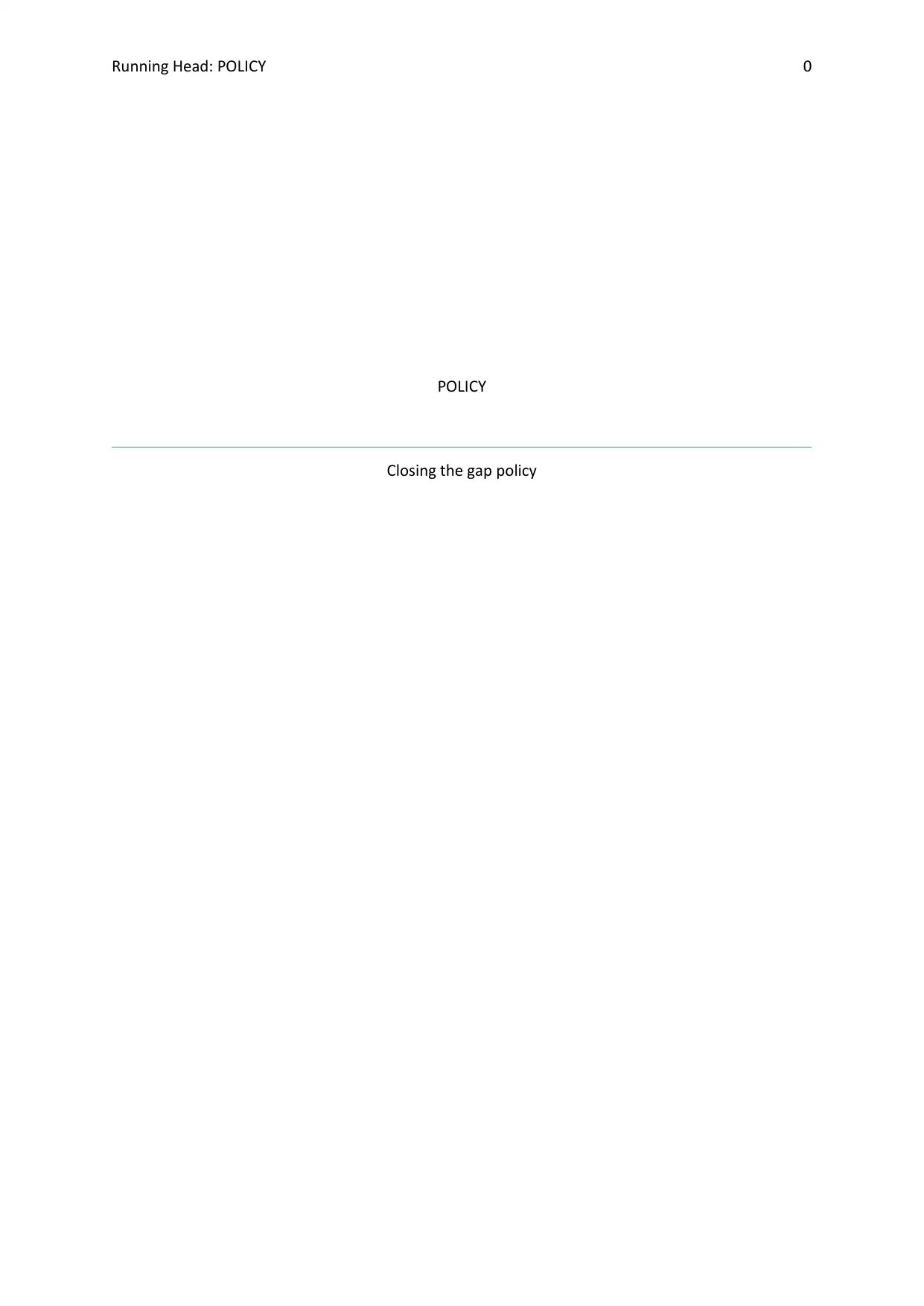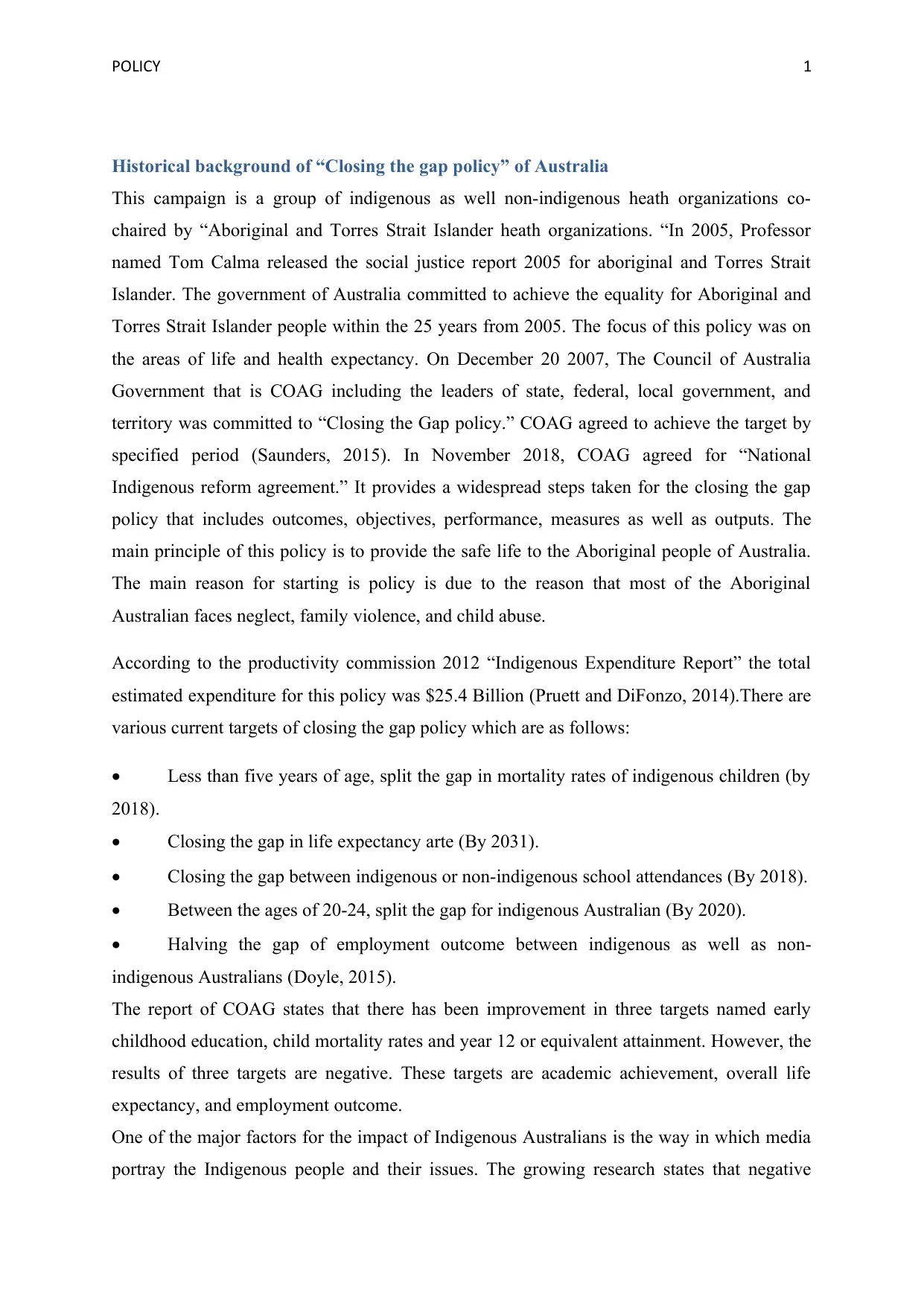Comprehensive Analysis of Australia's Closing the Gap Policy: A Report
VerifiedAdded on 2023/06/03
|4
|1083
|256
Report
AI Summary
This report provides a detailed analysis of Australia's 'Closing the Gap' policy, which aims to address inequalities faced by Aboriginal and Torres Strait Islander peoples. It begins with a historical overview, tracing the policy's origins to 2005 and its formalization in 2007. The report outlines the key targets of the policy, including reducing child mortality, increasing life expectancy, improving school attendance, and boosting employment outcomes. It examines the progress made towards these targets, highlighting both successes and areas where improvements have been limited. Furthermore, the report discusses the influence of media portrayal on Indigenous Australians and the government's initiatives to support Indigenous communities, including funding for health services and online safety training. The report references multiple sources to support its findings and offers a comprehensive overview of the policy's context, objectives, and impact.

Running Head: POLICY 0
POLICY
Closing the gap policy
POLICY
Closing the gap policy
Paraphrase This Document
Need a fresh take? Get an instant paraphrase of this document with our AI Paraphraser

POLICY 1
Historical background of “Closing the gap policy” of Australia
This campaign is a group of indigenous as well non-indigenous heath organizations co-
chaired by “Aboriginal and Torres Strait Islander heath organizations. “In 2005, Professor
named Tom Calma released the social justice report 2005 for aboriginal and Torres Strait
Islander. The government of Australia committed to achieve the equality for Aboriginal and
Torres Strait Islander people within the 25 years from 2005. The focus of this policy was on
the areas of life and health expectancy. On December 20 2007, The Council of Australia
Government that is COAG including the leaders of state, federal, local government, and
territory was committed to “Closing the Gap policy.” COAG agreed to achieve the target by
specified period (Saunders, 2015). In November 2018, COAG agreed for “National
Indigenous reform agreement.” It provides a widespread steps taken for the closing the gap
policy that includes outcomes, objectives, performance, measures as well as outputs. The
main principle of this policy is to provide the safe life to the Aboriginal people of Australia.
The main reason for starting is policy is due to the reason that most of the Aboriginal
Australian faces neglect, family violence, and child abuse.
According to the productivity commission 2012 “Indigenous Expenditure Report” the total
estimated expenditure for this policy was $25.4 Billion (Pruett and DiFonzo, 2014).There are
various current targets of closing the gap policy which are as follows:
Less than five years of age, split the gap in mortality rates of indigenous children (by
2018).
Closing the gap in life expectancy arte (By 2031).
Closing the gap between indigenous or non-indigenous school attendances (By 2018).
Between the ages of 20-24, split the gap for indigenous Australian (By 2020).
Halving the gap of employment outcome between indigenous as well as non-
indigenous Australians (Doyle, 2015).
The report of COAG states that there has been improvement in three targets named early
childhood education, child mortality rates and year 12 or equivalent attainment. However, the
results of three targets are negative. These targets are academic achievement, overall life
expectancy, and employment outcome.
One of the major factors for the impact of Indigenous Australians is the way in which media
portray the Indigenous people and their issues. The growing research states that negative
Historical background of “Closing the gap policy” of Australia
This campaign is a group of indigenous as well non-indigenous heath organizations co-
chaired by “Aboriginal and Torres Strait Islander heath organizations. “In 2005, Professor
named Tom Calma released the social justice report 2005 for aboriginal and Torres Strait
Islander. The government of Australia committed to achieve the equality for Aboriginal and
Torres Strait Islander people within the 25 years from 2005. The focus of this policy was on
the areas of life and health expectancy. On December 20 2007, The Council of Australia
Government that is COAG including the leaders of state, federal, local government, and
territory was committed to “Closing the Gap policy.” COAG agreed to achieve the target by
specified period (Saunders, 2015). In November 2018, COAG agreed for “National
Indigenous reform agreement.” It provides a widespread steps taken for the closing the gap
policy that includes outcomes, objectives, performance, measures as well as outputs. The
main principle of this policy is to provide the safe life to the Aboriginal people of Australia.
The main reason for starting is policy is due to the reason that most of the Aboriginal
Australian faces neglect, family violence, and child abuse.
According to the productivity commission 2012 “Indigenous Expenditure Report” the total
estimated expenditure for this policy was $25.4 Billion (Pruett and DiFonzo, 2014).There are
various current targets of closing the gap policy which are as follows:
Less than five years of age, split the gap in mortality rates of indigenous children (by
2018).
Closing the gap in life expectancy arte (By 2031).
Closing the gap between indigenous or non-indigenous school attendances (By 2018).
Between the ages of 20-24, split the gap for indigenous Australian (By 2020).
Halving the gap of employment outcome between indigenous as well as non-
indigenous Australians (Doyle, 2015).
The report of COAG states that there has been improvement in three targets named early
childhood education, child mortality rates and year 12 or equivalent attainment. However, the
results of three targets are negative. These targets are academic achievement, overall life
expectancy, and employment outcome.
One of the major factors for the impact of Indigenous Australians is the way in which media
portray the Indigenous people and their issues. The growing research states that negative

POLICY 2
media portrayal in relation to Indigenous Australian disseminates the discriminatory
stereotypes among the wide number of people. This type of racism puts negative impact on
the health of those indiogeneous Australians. 74% of media articles about the Indigenous
Australians were negative. For closing the gap policy, media is less interested for the
Indigenous Australians (Brown et al, 2017).
The target to split the gap in child mortality is on track. The indigenous child mortality rate is
declined by 35 per cent. Besides this, target for 95 percent of Indigenous four year old to get
early education by 2025 is also on tract (Krakouer, 2016). Until 2016, approx. 14,700
children’s were enrolled in childhood programs. On 12 February 2018, Prime Minister
presented the tenth “Closing the Gap” report to parliament. The Australia government is
taking government approach for the program development and policy by delivering services
to support the Aboriginal and Torres Strait Islander people. Ministers, agencies and
departments from education, health, environment are working together to ensure the
effectiveness of this policy.
The National Aboriginal and Torres Strait Islander plan 2013-2023 states the Australian
principles, vision, strategies, priorities to deliver the health outcome for those Indigenous
Australians. The implementation plan of this policy presents the actions that are taken by
government, stakeholders under health plan and community of aboriginal health sector.
Australian government is committed to improve the law as well as justice outcome for the
Indigenous Australian. By forming the “closing the gap policy” Aboriginal people is getting
all the right that is with the common people of Australia. For this, eSafety commissioner is
taking several initiatives for enhancing the online safety. The commissioner has recently
begun a digital literacy and online safety training tool for the people in remote indigenous
communities (Birch and Marshall, 2018). For these indigenous people, government funds
more than 80 countries to deliver the drug services and specific alcohol for indigenous
people. Government has done overall funding of around $70 million for the drug treatment
services.
media portrayal in relation to Indigenous Australian disseminates the discriminatory
stereotypes among the wide number of people. This type of racism puts negative impact on
the health of those indiogeneous Australians. 74% of media articles about the Indigenous
Australians were negative. For closing the gap policy, media is less interested for the
Indigenous Australians (Brown et al, 2017).
The target to split the gap in child mortality is on track. The indigenous child mortality rate is
declined by 35 per cent. Besides this, target for 95 percent of Indigenous four year old to get
early education by 2025 is also on tract (Krakouer, 2016). Until 2016, approx. 14,700
children’s were enrolled in childhood programs. On 12 February 2018, Prime Minister
presented the tenth “Closing the Gap” report to parliament. The Australia government is
taking government approach for the program development and policy by delivering services
to support the Aboriginal and Torres Strait Islander people. Ministers, agencies and
departments from education, health, environment are working together to ensure the
effectiveness of this policy.
The National Aboriginal and Torres Strait Islander plan 2013-2023 states the Australian
principles, vision, strategies, priorities to deliver the health outcome for those Indigenous
Australians. The implementation plan of this policy presents the actions that are taken by
government, stakeholders under health plan and community of aboriginal health sector.
Australian government is committed to improve the law as well as justice outcome for the
Indigenous Australian. By forming the “closing the gap policy” Aboriginal people is getting
all the right that is with the common people of Australia. For this, eSafety commissioner is
taking several initiatives for enhancing the online safety. The commissioner has recently
begun a digital literacy and online safety training tool for the people in remote indigenous
communities (Birch and Marshall, 2018). For these indigenous people, government funds
more than 80 countries to deliver the drug services and specific alcohol for indigenous
people. Government has done overall funding of around $70 million for the drug treatment
services.
⊘ This is a preview!⊘
Do you want full access?
Subscribe today to unlock all pages.

Trusted by 1+ million students worldwide

POLICY 3
References
Birch, E. and Marshall, D. (2018) Revisiting the earned income gap for Indigenous and non-
Indigenous Australian workers: Evidence from a selection bias corrected model. Journal of
Industrial Relations, 60(1), pp.3-29.
Brown, L., Osborne, K., Walker, R., Moskos, M., Isherwood, L., Patel, K., Baum, F. and
King, D. (2017) The benefits of a life-first employment program for Indigenous Australian
families: Implications for ‘Closing the Gap’. Journal of Social Inclusion, 8(1), pp.78-95.
Doyle, K.E. (2015) Australian Aboriginal peoples and evidence-based policies: closing the
gap in social interventions. Journal of evidence-informed social work, 12(2), pp.166-174.
Krakouer, J. (2016) Aboriginal Early Childhood Education: Why attendance and true
engagement are equally important. United Kingdom: Routledge.
Pruett, M.K. and DiFonzo, J.H. (2014) Closing the gap: Research, policy, practice, and
shared parenting. Family Court Review, 52(2), pp.152-174.
Saunders, P. (2015) Closing the gap: the growing divide between poverty research and policy
in Australia. Australian Journal of Social Issues, 50(1), pp.13-35.
References
Birch, E. and Marshall, D. (2018) Revisiting the earned income gap for Indigenous and non-
Indigenous Australian workers: Evidence from a selection bias corrected model. Journal of
Industrial Relations, 60(1), pp.3-29.
Brown, L., Osborne, K., Walker, R., Moskos, M., Isherwood, L., Patel, K., Baum, F. and
King, D. (2017) The benefits of a life-first employment program for Indigenous Australian
families: Implications for ‘Closing the Gap’. Journal of Social Inclusion, 8(1), pp.78-95.
Doyle, K.E. (2015) Australian Aboriginal peoples and evidence-based policies: closing the
gap in social interventions. Journal of evidence-informed social work, 12(2), pp.166-174.
Krakouer, J. (2016) Aboriginal Early Childhood Education: Why attendance and true
engagement are equally important. United Kingdom: Routledge.
Pruett, M.K. and DiFonzo, J.H. (2014) Closing the gap: Research, policy, practice, and
shared parenting. Family Court Review, 52(2), pp.152-174.
Saunders, P. (2015) Closing the gap: the growing divide between poverty research and policy
in Australia. Australian Journal of Social Issues, 50(1), pp.13-35.
1 out of 4
Related Documents
Your All-in-One AI-Powered Toolkit for Academic Success.
+13062052269
info@desklib.com
Available 24*7 on WhatsApp / Email
![[object Object]](/_next/static/media/star-bottom.7253800d.svg)
Unlock your academic potential
Copyright © 2020–2025 A2Z Services. All Rights Reserved. Developed and managed by ZUCOL.





